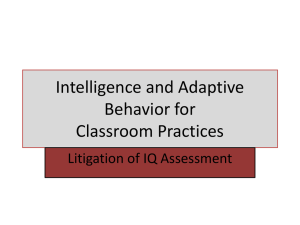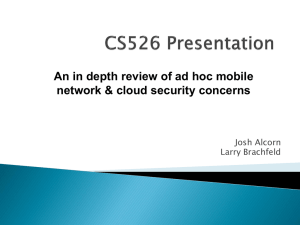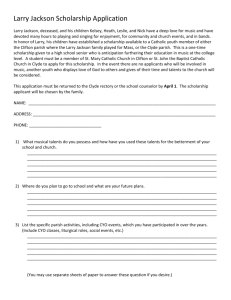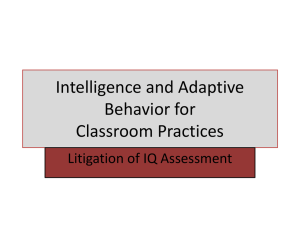Lorenzo J - Department of Physics and Astronomy
advertisement
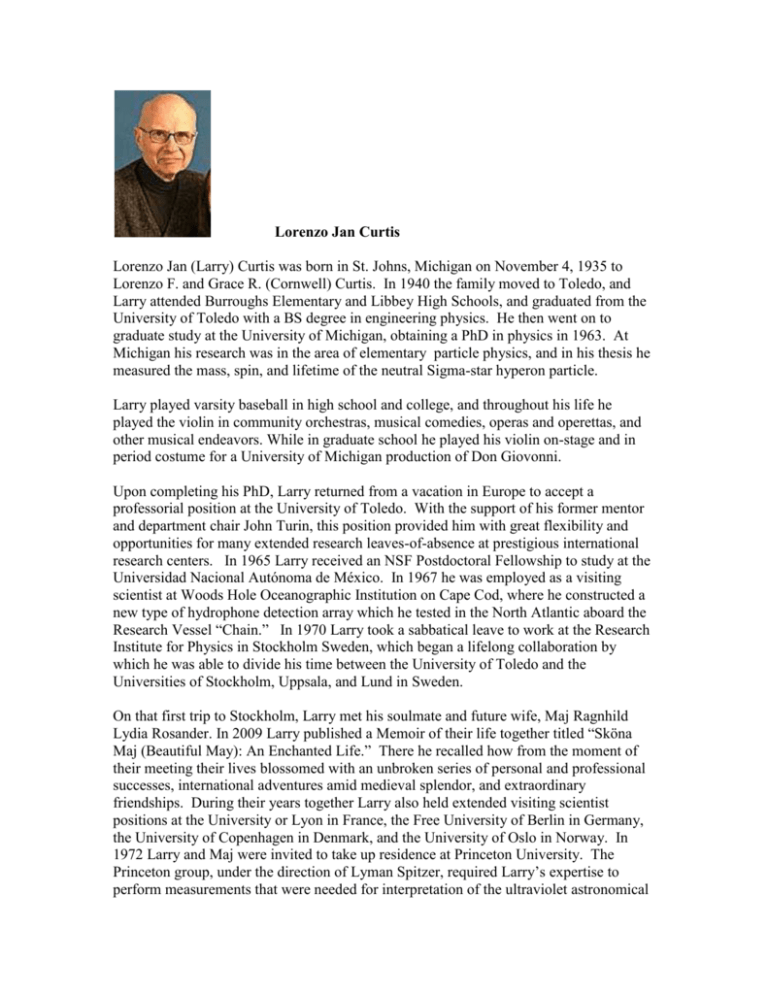
Lorenzo Jan Curtis Lorenzo Jan (Larry) Curtis was born in St. Johns, Michigan on November 4, 1935 to Lorenzo F. and Grace R. (Cornwell) Curtis. In 1940 the family moved to Toledo, and Larry attended Burroughs Elementary and Libbey High Schools, and graduated from the University of Toledo with a BS degree in engineering physics. He then went on to graduate study at the University of Michigan, obtaining a PhD in physics in 1963. At Michigan his research was in the area of elementary particle physics, and in his thesis he measured the mass, spin, and lifetime of the neutral Sigma-star hyperon particle. Larry played varsity baseball in high school and college, and throughout his life he played the violin in community orchestras, musical comedies, operas and operettas, and other musical endeavors. While in graduate school he played his violin on-stage and in period costume for a University of Michigan production of Don Giovonni. Upon completing his PhD, Larry returned from a vacation in Europe to accept a professorial position at the University of Toledo. With the support of his former mentor and department chair John Turin, this position provided him with great flexibility and opportunities for many extended research leaves-of-absence at prestigious international research centers. In 1965 Larry received an NSF Postdoctoral Fellowship to study at the Universidad Nacional Autónoma de México. In 1967 he was employed as a visiting scientist at Woods Hole Oceanographic Institution on Cape Cod, where he constructed a new type of hydrophone detection array which he tested in the North Atlantic aboard the Research Vessel “Chain.” In 1970 Larry took a sabbatical leave to work at the Research Institute for Physics in Stockholm Sweden, which began a lifelong collaboration by which he was able to divide his time between the University of Toledo and the Universities of Stockholm, Uppsala, and Lund in Sweden. On that first trip to Stockholm, Larry met his soulmate and future wife, Maj Ragnhild Lydia Rosander. In 2009 Larry published a Memoir of their life together titled “Sköna Maj (Beautiful May): An Enchanted Life.” There he recalled how from the moment of their meeting their lives blossomed with an unbroken series of personal and professional successes, international adventures amid medieval splendor, and extraordinary friendships. During their years together Larry also held extended visiting scientist positions at the University or Lyon in France, the Free University of Berlin in Germany, the University of Copenhagen in Denmark, and the University of Oslo in Norway. In 1972 Larry and Maj were invited to take up residence at Princeton University. The Princeton group, under the direction of Lyman Spitzer, required Larry’s expertise to perform measurements that were needed for interpretation of the ultraviolet astronomical spectra that were being obtained for the first time from the Copernicus satellite. In 1976 Larry was offered a faculty position at the University of Lund in Sweden (Maj was a graduate of Lund). By arranging a collaborative program between the Universities of Lund and Toledo, a program was developed whereby Larry held joint positions at the two Universities, alternating years in residence at each of the two institutions. During his long career, Larry received extensive and continuous funding for his research form the National Science Foundation, the US Department of Energy, the Swedish Research Council, and the Nordic Institute for Theoretical Atomic Physics. He was elevated to the rank of Fellow of both the American Physical Society and the American Optical Society, and in 1990 he was the recipient of the Gunnar and Gunnel Källén Memorial Prize awarded by the Royal Swedish Physiographical Society. Larry’s research efforts resulted in well over 200 scholarly scientific papers, a respected graduate textbook on Atomic Structure, and numerous co-authored monographs on scientific subjects. While living in Lund, Maj and Larry became friends with Guy and Mattie von Dardel. Guy was the half-brother of Raoul Wallenberg, the Swedish diplomat who saved the lives of thousands of Jews in Budapest Hungary during the World War II, arguably among the most heroic figures of the 20th century. Guy and Mattie visited Larry and Maj in Toledo. Guy spoke at UT and met with people at the University, providing a moving experience to the many who attended. For many years Larry served as editor for atomic, molecular and optical physics for Physica Scripta, the archival research journal of the Royal Swedish Academy of Sciences. In 1995, the Nobel Prize in Physics was shared by Martin Perl, an old friend and mentor to Larry at the University of Michigan. As a gesture of gratitude for his service, Larry and Maj were invited to travel to Stockholm to attend the Awards Ceremony, to share memories with Marty Perl, and to attend the Banquet with King Karl Gustav, Queen Silvia, and Crown Princess Victoria. While Larry was an undergraduate student at the University of Toledo, he was very moved by the film “Wild Strawberries” by the Swedish director Ingmar Bergman. The film is centered about the award of an Honorary Doctorate by the University of Lund to a distinguished professor. This scene portrays the highest glory of medieval academic pageantry. It begins with an academic processional down from the university, through the wall of the ancient city, and into the romanesque cathedral (consecrated in 1145). This was accompanied by trumpet fanfares, garland girls spreading flower petals, and masses of people lining the route. Inside the cathedral the ceremony was conducted entirely in Latin. At the moment of the conferring of the Honorary Doctorate, a laurel wreath was placed on the head and a ring was placed on the finger of the recipient, and a canon salute was fired off on the village green. At the conclusion of the ceremony the recessional was accompanied by triumphant music, ringing of the tower bells, and a saber salute was presented by a contingent of soldiers in period uniforms. The earlier film vision became a reality when in 1999 the University of Lund chose to award an Honorary Doctorate (Philosophia Doctor Honoris Causa) on Larry for his many contributions to US and Swedish science. Since this great honor given to Larry was awarded by Maj’s alma mater, it represented a high point in their enchanted lives. In March 2002 Maj was diagnosed with ovarian cancer, and began a rigorous program of surgery and chemotherapy. Larry retired from both his University position and from his research grant with the US Department of Energy. For nearly five years they continued to have active and rewarding lives, traveling extensively and relaxing on vacations on Maj’s family farm in the forests of Småland in Sweden, and in the lush gardens of the Dingle Peninsula in Ireland. May passed away on November 1, 2006. Larry subsequently resumed his scientific research, and also wrote a number of pedagogic articles proposing radical revisions in the teaching of elementary physics.

